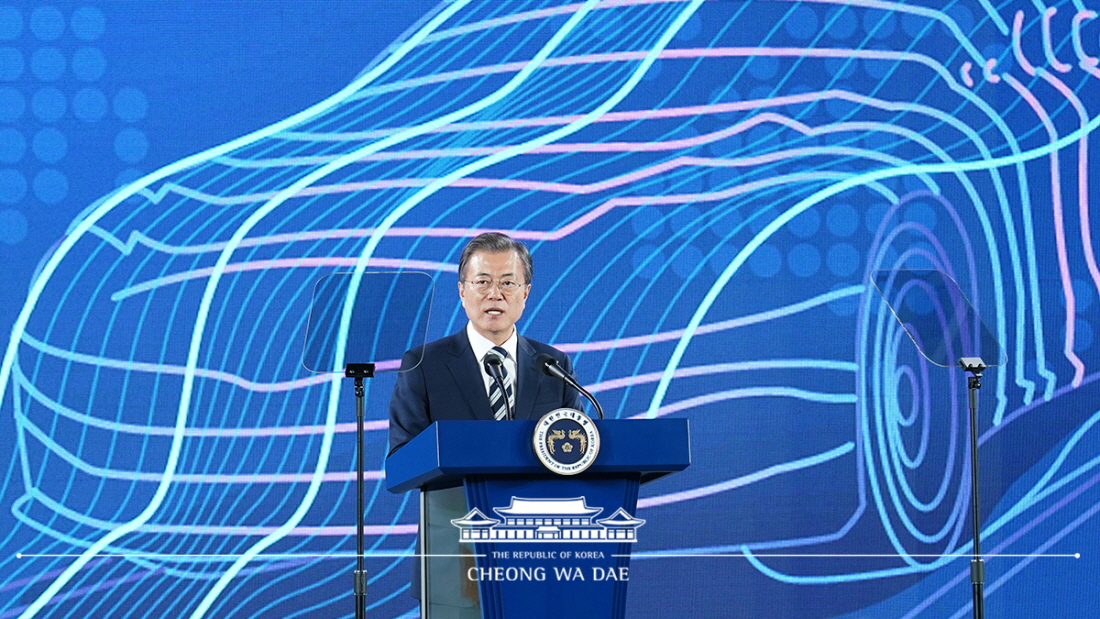이 웹사이트는 제19대 대통령 임기 종료에 따라 대통령기록관이 「대통령기록물 관리에 관한 법률」에 의해 이관받아 서비스하는 대통령기록물입니다. 자료의 열람만 가능하며 수정 · 추가 · 삭제는 불가능합니다.
다만, 「개인정보보호법」에 의하여 개인의 정보를 보호받기 원하시는 분은 관련 내용(요청자, 요청내용, 연락처, 글위치)을 대통령 웹기록물 담당자(044-211-2253)에게 요청해 주시면 신속히 검토하여 조치해 드리겠습니다. 감사합니다.
SPEECHES & REMARKS
BRIEFINGS
Remarks by President Moon Jae-in at Future Car Industry National Vision Declaration Ceremony

Fellow Koreans,
We are holding a ceremony here today at Hyundai Motor Group’s Namyang R&D Center together with the main architects of the future automobile industry to declare a future car national vision.
Hyundai Motor Group started research and development on eco-friendly cars in 1997 and succeeded in mass-producing hydrogen-powered cars for the first time in the world. Its accumulated sales of one million eco-friendly cars should be credited to the researchers working here. As President, I applaud them.
We grew up reading stories about great inventors from the industrial age: James Watt making the first steam engine, the Wright brothers flying the first plane and Thomas Edison harnessing electricity. We read about them, nourished our dreams and envied their achievements at times.
However, the phrase “the world’s first” is no longer uncommon in our country. Korea has already become a country of “world firsts” in various fields. Just in the automobile sector alone, the Republic of Korea’s scientists and engineers have become the central players in the creation of the world’s first lithium battery for electric vehicles, the first mass-production of a hydrogen car and the world’s first commercialization of 5G technology.
We have sprinted without rest to catch up with those countries that began industrialization early on. As a result, Korea has become the seventh largest automobile manufacturer in the world, producing four million cars per year. Obviously, however, there is a limit to the fast-follower model economy.
In the age of future cars, we do not have to be a fast follower any longer. That is because we have been able to take our place on an equal starting line. At last, we have the chance to become a pacesetter in technology, not a fast follower. We have to seize this opportunity.
We have already proven our world-class technological prowess in electric and hydrogen vehicles. This year, we became the world’s largest seller of hydrogen cars. There’s more good news: 1,600 of our hydrogen trucks for export will be shipped to Switzerland. In addition, our electric vehicles have obtained one of the highest electricity efficiency ratings in the world as well. Also unrivaled globally is our development of the technologies essential for running future cars: batteries, semiconductors and IT. Combining these technologies with the world’s fastest mobile network will enable us to lead autonomous driving and attain a dominant position in the future car market. The era of Korea setting global standards can never be called a dream.
Fellow Koreans,
In 2030, approximately 30 percent of newly produced automobiles will be hydrogen or electric vehicles while more than 50 percent of the total will be self-driving. The market for Mobility as a Service (MaaS) will swell to US$1.5 trillion.
As a response to climate change, some European countries have already announced bans on the sale of cars running on internal combustion engines starting in 2025. Global car manufacturers are also concentrating on the development of eco-friendly automobiles. Environmentally friendly vehicles have now become a must, not an option.
Going beyond the ease of use, self-driving vehicles can drastically reduce traffic accidents and help give the vulnerable in terms of transportation the access to safe mobility that is their right. Germany has announced its plans to commercialize fully autonomous cars by 2030, and the United States is operating a pilot city for self-driving. In this manner, countries around the world are speeding up their efforts for automated driving.
Fueled by the development of flying cars, the market for future car services is expected to grow by 30 percent every year.
Our goal is to become the most competitive country in terms of future vehicles by 2030. To this end, the Government has formulated three policy directions.
First, domestic sales of electric and hydrogen vehicles should make up 33 percent of the Korea’s total new vehicle sales in 2030 – the highest ranking worldwide – and we will strive to achieve a global market share of 10 percent.
We will set goals that require car manufacturers to roll out a certain number of eco-friendly vehicles and expand the domestic market with a focus on the means for logistics and public transportation, including compact cars, buses, taxis and trucks.
In addition, as demand increases, we will install 15,000 rapid chargers for electric vehicles by 2025, making them more accessible than gas stations, and a total of 660 hydrogen fueling stations will be built by 2030, which will make it possible to reach a station within 20 minutes from any part of the country.
Future cars are eco-friendly and reduce fine dust and greenhouse gases, and notably, hydrogen vehicles are “running air purifiers.” If we meet the goal of making future cars account for 33 percent of all new car sales, it would have the effect of reducing greenhouse gases by 36 percent and fine dust by 11 percent.
Second, we will strive to become the first country in the world to commercialize self-driving vehicles.
While our self-driving policy to date has centered on autonomous driving allowed only on designated portions of roads with drivers present, or Level 3, we’ve raised our goals. We will commercialize fully autonomous vehicles that will run on major roads without driver control, with the target date also advanced three years to 2027 from 2030.
To that end, by 2024, along with preparation of the relevant legal and institutional frameworks, we will have fully completed on major roads four key infrastructure projects: wireless communication networks between cars and roads, detailed three-dimensional mapping, an integrated traffic control system and road signs. Befitting the era when cars drive themselves, we will amend such relevant laws and regulations as safety standards and insurance liability to ensure that there won’t be any confusion concerning the responsibility for safety and accidents.
In order to secure the driving technology needed to handle complex urban areas, the public sector will play a leading role in expanding related pilot services. We will conduct test runs for self-driving shuttles and robot taxis with a focus on the elderly and areas that are disadvantaged in terms of transport services. In addition, we will expand the development of necessary technologies and demonstrations by focusing on nine public services, including traffic monitoring, emergency response to vehicle failures and autonomous patrols.
Self-driving services offer a golden market that will revitalize the economy and create new jobs. Through the regulatory sandbox system and special regulation-free zones, we will further speed up deregulation. Next year, we will select a pilot zone for the operation of self-driving passenger transport and logistics and will permit a transport business within the pilot zone.
If autonomous vehicles penetrate the market enough to account for 54 percent of all cars in 2030, the number of deaths from car accidents will decline from around 3,800 to fewer than one thousand annually and time stuck in traffic will fall by 30 percent.
Third, we will create an ecosystem of innovation and mutual benefit that will guide the future car industry.
Korean companies plan to invest 60 trillion won in the future car industry over the next decade, thereby securing key technologies that can lead the world. The Government will invest 2.2 trillion won to develop and demonstrate future car-related components and materials to support private-sector innovation. The results of our technological development of hydrogen vehicles and autonomous cars will be put forth as international standards so that our technologies can become the global norm.
Innovation through the convergence of different industries constitutes the key to competitiveness for future cars. We will nurture professionals in various areas needed for future cars and create an open ecosystem so industries as different as the automobile, semiconductor, IT, artificial intelligence and service – as well as large companies and SMEs – can cooperate with each other, thereby allowing us to lead the future car industry with our own competence and technology.
Smart cities will become large testing grounds for future cars, and they will provide opportunities for the people to experience future car services and for businesses to test their products’ performance and safety. In addition, we will build technological demonstration complexes in provincial centers to ensure that SMEs, mid-market companies and startups have ready access.
When the future car era begins in earnest, we will also have to address concerns about the large loss of jobs in the conventional automobile as well as components and materials industries.
The Government will actively support business transformation in the existing component industry. It will also help create new markets for convergence components, services and software through regulatory reform to ensure an increase in the total number of jobs created. I would like to point out that mutually beneficial cooperation among auto-related industries and labor unions with regard to employment is also essential to prepare for the era of future cars.
Fellow Koreans,
In future cars, we will be the world’s first and the world’s best.
In February last year, I had a test ride in an autonomous hydrogen car during a trial run on the Gyeongbu Express Way. By watching the vehicle adjust its speed by itself, maintain a distance from other cars and change lanes, I could verify the technological standing of our autonomous vehicles. Also, the presidential vehicle that I rode in to this event today is our hydrogen vehicle Nexo.
We will lead the era of the Fourth Industrial Revolution through future vehicles. We are fully prepared to lead the new technological era, and we also have passion. If the people show their support, we will certainly see the Republic of Korea become the No. 1 future car nation before long.
Thank you.



